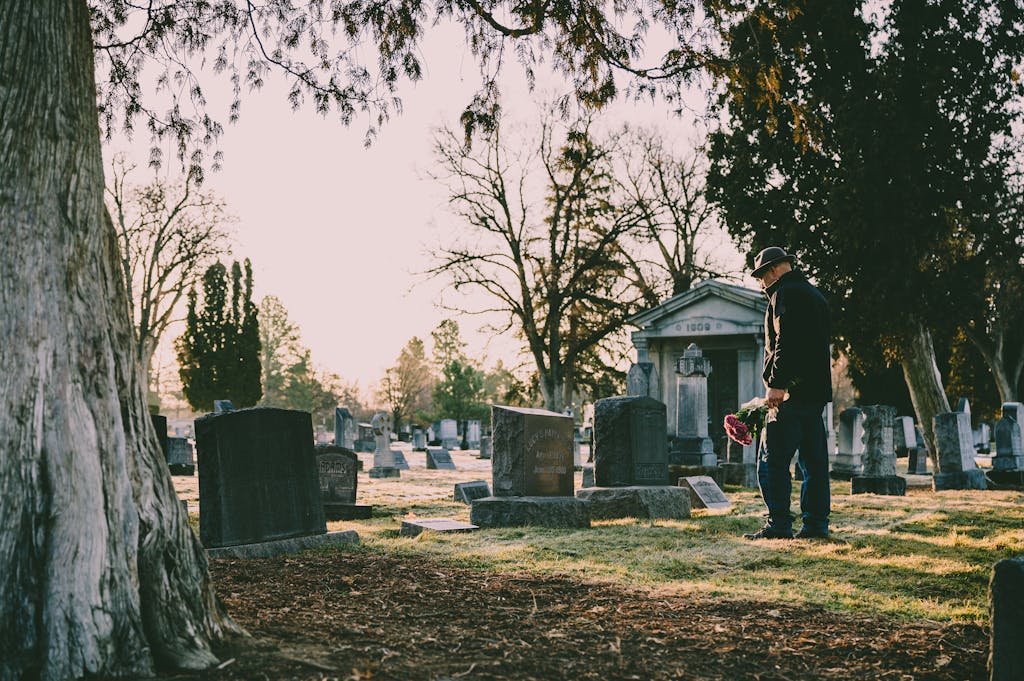Rules for Visiting Cemeteries: A Complete Guide
Visiting cemeteries is an act of respect, remembrance, and reflection. Whether you are attending a funeral, visiting a loved one’s grave, or simply walking through a historic cemetery, it’s important to understand the rules for visiting cemeteries. These guidelines are not just about etiquette but also about preserving sacred grounds for future generations.
Below, we’ll explore common rules for visiting cemeteries, traditions, and respectful practices to keep in mind whenever you step into these solemn spaces.

Why Cemetery Rules Matter
Cemeteries are more than just places where people are buried. They are memorial grounds, cultural landmarks, and often historic sites. Because of this, cemeteries typically have formal and informal rules in place. Following these rules ensures that you:
- Show respect for grieving families.
- Avoid damaging fragile headstones or landscaping.
- Maintain peace and quiet in a sacred environment.
- Help preserve history for future visitors.
If you’ve never visited a graveyard before, knowing the rules for visiting cemeteries can help you avoid unintentional mistakes.
General Rules for Visiting Cemeteries
While each cemetery may have specific policies, there are universal guidelines everyone should follow:
1. Show Respect at All Times
A cemetery is not a park or playground. Visitors should walk calmly, speak quietly, and avoid disruptive behavior. Think of it as entering a church or other sacred space.
2. Follow Visiting Hours
Most cemeteries open during daylight hours and close in the evening. Visiting outside of posted times is typically considered trespassing. Always check the hours before planning a visit.
3. Stay on Designated Paths
Walking directly across graves is often seen as disrespectful and can cause damage to older headstones. Stick to walkways and roadways unless visiting a specific grave.
4. Mind Your Noise Level
Keep conversations low and avoid loud laughter, music, or phone calls. Many people come to cemeteries for quiet reflection.
5. Leave No Trace
Do not litter, and avoid leaving behind food, wrappers, or other trash. If you bring flowers or decorations, make sure they comply with the cemetery’s policies.
Cultural and Religious Considerations
Cemeteries often reflect cultural and religious traditions. For example:
- Jewish cemeteries: It is customary to place a small stone on the grave instead of flowers.
- Catholic cemeteries: Visitors may see religious symbols such as crosses, rosaries, or candles.
- Military cemeteries: Flags and special decorations are common, particularly on Memorial Day or Veterans Day.
Understanding these customs is part of following the unspoken rules for visiting cemeteries respectfully.
Photography and Filming in Cemeteries
Many people enjoy photographing historic headstones or beautiful cemetery landscapes. However, photography comes with its own rules:
- Always check if the cemetery allows photography.
- Avoid taking pictures of other visitors or grieving families without permission.
- Be mindful of funeral services — cameras are never appropriate during active ceremonies.
For genealogists or history buffs, photographing old gravestones can be a way to preserve history, but it must always be done respectfully.
Bringing Children and Pets
Cemeteries can be educational places for children, teaching them about history, respect, and family heritage. However, it’s important to supervise kids closely. Running, shouting, or playing games is not appropriate.
As for pets, many cemeteries prohibit animals unless they are service animals. Even when permitted, pets should always be leashed and kept away from graves.
Decoration Rules for Graves
When decorating a grave, follow both etiquette and cemetery regulations. Common guidelines include:
- Fresh or artificial flowers are usually allowed.
- Balloons, glass containers, or permanent fixtures may be prohibited.
- Seasonal decorations may be permitted but often must be removed after a set period.
If you’re unsure, check with the cemetery office before placing items. This ensures you follow the official rules for visiting cemeteries and respecting grave sites.
Safety Considerations
Older cemeteries may have uneven ground, crumbling stones, or sunken graves. To stay safe:
- Wear appropriate footwear.
- Avoid leaning on or climbing headstones.
- Watch children closely around fragile markers.
These rules not only protect you but also help preserve monuments that are hundreds of years old.
What Not to Do in a Cemetery
Sometimes it’s easier to remember the don’ts:
- Don’t disturb flowers, flags, or decorations left by others.
- Don’t engage in recreational activities such as picnics or sports.
- Don’t damage headstones by rubbing, chalking, or leaning on them.
- Don’t bring alcohol or drugs onto cemetery property.
- Don’t use cemeteries for paranormal investigations without explicit permission.
These behaviors go against the core rules for visiting cemeteries and can even be illegal in some jurisdictions.
Cemeteries as Historical and Cultural Spaces
Many cemeteries serve as outdoor museums, reflecting art, architecture, and history. Famous cemeteries like Arlington National Cemetery or Père Lachaise in Paris attract millions of visitors each year. If you’re visiting for tourism or history, remember that the rules for visiting cemeteries still apply — even if the grounds are popular sightseeing spots.
Preparing for Your Visit
Before going, take a few steps to make your trip respectful and meaningful:
- Research the cemetery’s visiting hours and regulations.
- Bring flowers or tokens that are appropriate for the cemetery’s traditions.
- Dress modestly and appropriately for the occasion.
- Learn a little about the site’s history if it is a well-known cemetery.
By preparing, you ensure your visit is both respectful and fulfilling.
Frequently Asked Questions — Rules for Visiting Cemeteries
What’s the difference between a graveyard and a cemetery?
A graveyard is typically part of church grounds, whereas a cemetery is a standalone resting place—often more expansive and secular in function. Both serve as burial sites, but the usage tends to reflect different historical and institutional contexts.
What is appropriate to leave at a gravesite?
Many cemeteries allow flowers, coins for veterans, and in Jewish traditions, small stones placed on the headstone as a mark of lasting remembrance. Always check the cemetery’s specific decoration guidelines to avoid prohibited items.
Can I photograph in a cemetery?
Photography rules vary. Casual, non-commercial snapshots are often permitted. However, avoid photographing people, funerals, or markers with identifying details without permission. Always respect privacy and existing rules.
What should I know about cemetery visiting hours?
Most cemeteries are open during daylight hours; offices may close earlier or only be open on weekdays. Gates generally close at the posted time, so plan accordingly to avoid being locked in.
Are pets allowed in cemeteries?
Policies vary: some cemeteries prohibit pets, others allow service animals only. If you plan to bring a pet, call ahead to confirm the cemetery’s rules.
What behavior is expected during a cemetery visit?
Maintain quiet and calm. Stick to walkways, avoid walking directly over graves, and never touch or lean on headstones. Show sensitivity, especially around mourners and ongoing services.
Can I have a picnic or eat during a cemetery visit?
In most cemeteries—particularly religious or secular memorial grounds—picnicking, loud gatherings, and celebrations are prohibited as they can be deemed disrespectful.
Is it okay to visit a cemetery even if I don’t have a personal connection there?
Yes—many people visit cemeteries to reflect, appreciate history, or find peace. Doing so is acceptable as long as you maintain respect and decorum.

Pingback: Can You Install a Headstone in Winter? | Full Guide